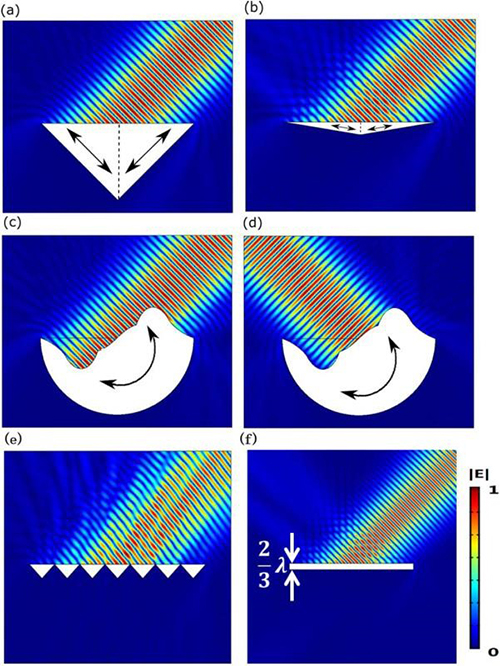A retro-reflector can create reflected wave that is always parallel to, but in the opposite direction of, the incoming wave. Previous retro-reflector can be classified into two types: one is bulk device, including corner-cube reflector, cat's eyes reflector and Eaton lens, which cannot be integrated with planar modulators; the other is thin meta-surface retro-reflector, whose efficiency drops quickly as the viewing angle changes. To achieve planar thin retro-reflector with high efficiency and wide working angles, optical surface transformation (OST) can be used to design arbitrarily shaped retro-reflector.
Optical surface transformation is a new branch of transformation optics, of which advantages can be summarized as: 1) it provides a much simpler way to make designs (i.e., geometrical projection method without complex mathematical calculations); 2) all devices with various functions, geometrics and sizes designed by OST only need one kind of materials (i.e., optic-null medium with different shapes and main axes to realize); 3) it can be easily extended to other physical fields or even multi-physics controlling simultaneously.
Recently, research groups led by Prof. Fei Sun and Prof. Yichao Liu from Taiyuan University of Technology, and Sailing He from Zhejiang University introduced a new type of retro-reflector in Chinese Optics Letters Volume 18, No. 10, 2020 (Fei Sun, Yichao Liu, Yibiao Yang et al., Arbitrarily shaped retro-reflector by optics surface transformation). Based on OST, retro-reflector is designed by a surface-projecting manner in this study. The designed retro-reflector may have applications in planar integrated systems, compact sensors, navigation, and communication systems.
Based on OST, the retro-reflector can be designed as a thin planar slab with thickness 2λ0/3, whose efficiency is above 98% with incident angles from -50 degrees to +50 degrees, and is still above 50% even as the incident angle increases to 80 degree. All retro-reflectors designed by OST only require one kind of homogeneous anisotropic media (optic-null medium) to realize (the orientation of the homogeneous ONMs' main axes may be different).
In this work, the authors use an ultra-thin metamaterial to realize the retro-reflection effect. This is a big improvement compared with the traditional space-consuming retro-reflectors. What's more, the required materials are quite simple, i.e., near-zero-index metamaterials and metal plates, which meet the requirements of mass production. One unique feature of the designed retro-reflector is the shaped can be tuned at will, and this flexibility provides more choices in some special applications. In conclusion, this work provides more flexible shapes of the retro-reflector, and at the same time keep an excellent retro-reflection efficiency.
There are two limitations of our work for real application, one is the introduction of near-zero-index materials and the other is the restriction to only one polarization. Therefore, our follow-up work is the replacing of the near-zero-index materials by normal dielectrics. Also, the retro-reflector should also be extended to work for both TE waves and TM waves. The direction of incident beam should also be extended for the whole upper half plane. After solving the above problem, we plan to extend the retro-reflector to work for multi-physics, e.g., one device works for both electromagnetic and acoustic waves.

The geometric shapes of the retro-reflectors are (a) an isosceles triangle, (b) a flat triangle, (c), (d) irregular surfaces, and (e) an array of isosceles triangles.


